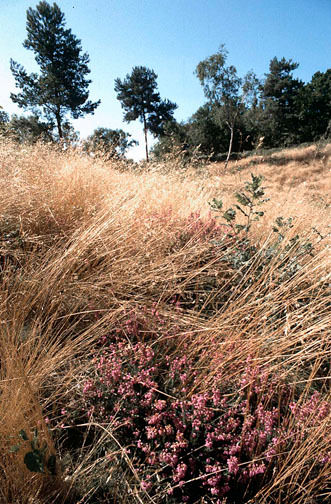Clearly Croydon has been much affected by development, changing it from a Surrey market town to a London suburb. The coming of the railways speeded the move from farmland with open fields and hedgerows, to sprawling dormitory town development. Much of our countryside has been lost. Where for example is the "heath" at Thornton Heath? Where is the "green" at Broad Green? Sometimes only area names and road names such as Parchmore (Parch Moor) and Green Lane hint at our lost countryside. It seems therefore that the desolate moorland of north Croydon haunted by footpads and highwaymen has gone forever, but other features still remain albeit a shadow of their former selves. On the northern hills overlooking Croydon stood the Great North Wood, immortalised today in the area we know as Norwood. Has this also been lost without trace? Not quite, remnants still remain at Biggin Wood, Beaulieu Heights and Convent Woods (private).


Beulah Hill Pond
The centre of Croydon fared no better; it was once an area of ponds and streams much prone to flooding and outbreaks of disease. The south of the present day borough has survived relatively unscathed. The Green Belt Act stopped much harmful development in its tracks and now amid the suburban semi-detached sprawl we have some sizeable areas of open countryside. Most of these areas have escaped the arrival of intensive farming and are therefore rather more "natural" than the "real countryside" further south in Surrey. In fact very little real farming now takes place in Croydon with just a few fields in the Addington area remaining under cultivation.

Croydon's open spaces tended to be thought of as "development opportunities" rather than land on which people's livelihood directly depends. Without the working woodlands, agriculture and grazing animals of the past, many areas became neglected. Ponds dried up, streams were banished underground, grassland and heathland became covered with scrubby trees, and woodlands became dark, forbidding places. The plants and animals that had become so dependent on these earlier habitats also became rarer or even extinct in Croydon. In addition nibbling rabbits were much reduced in numbers due to myxomatosis in the 1950s. According to Friends of the Earth we have lost in the UK, 30-50% of ancient woodland, 95% of flower-rich meadows, 80% of chalk grassland, and 40% of lowland heath. In Croydon these losses have been mainly due to housing development and scrub invasion.

South Norwood Country Park
During the 1980s it became clear that something had to be done, some existing groups such as the London Wildlife Trust and Surrey Wildlife Trust took on the management of some open spaces including Hutchinson's Bank and Dollypers Hill. Other groups came into being and the Association of Croydon Conservation Societies was formed taking on the role of bringing these groups together for mutual benefit and to discuss matters relevant to Nature Conservation. Over the following years we have seen a slow improvement in Croydon's open spaces. Some woodlands including King's Wood have seen the reintroduction of coppicing that has let in more light to benefit plants such as the Bluebell and Wood Anemone. Chalk downland and heathland is being cleared of scrub, some of which is now grazed by sheep, cattle and goats to maintain the short grassland on which butterflies and many other insects depend. Ponds are also managed to prevent them silting up or being overrun with aggressive non-native plants.

Hutchinson's Bank


Happy Valley
Kings Wood
The member groups of ACCS and other groups in Croydon vary a great deal in size and the type of commitment to parks and open spaces. Some for example act as the "eyes and ears" of a particular area, reporting vandalism and rubbish dumping, others actually take part in the practical management of a site under the guidance and permission of Croydon Council or the City of London. If you would like to take part in any way to improve your local environment why not use this website to see if there is an existing group where you live, or perhaps start a new group by contacting ACCS.

Croydon's countryside
Did you think that Croydon was covered in concrete and tarmac and only contains skyscrapers and shops? Well think again! Ancient woodland, heathland and chalk grassland are just a few of the natural habitats to be found amid the rolling hills of both north and south Croydon.


Biggin Woods
Bradmore Green Pond
Addington Hills
Jacob sheep at Riddlesdown

Biggin Wood
